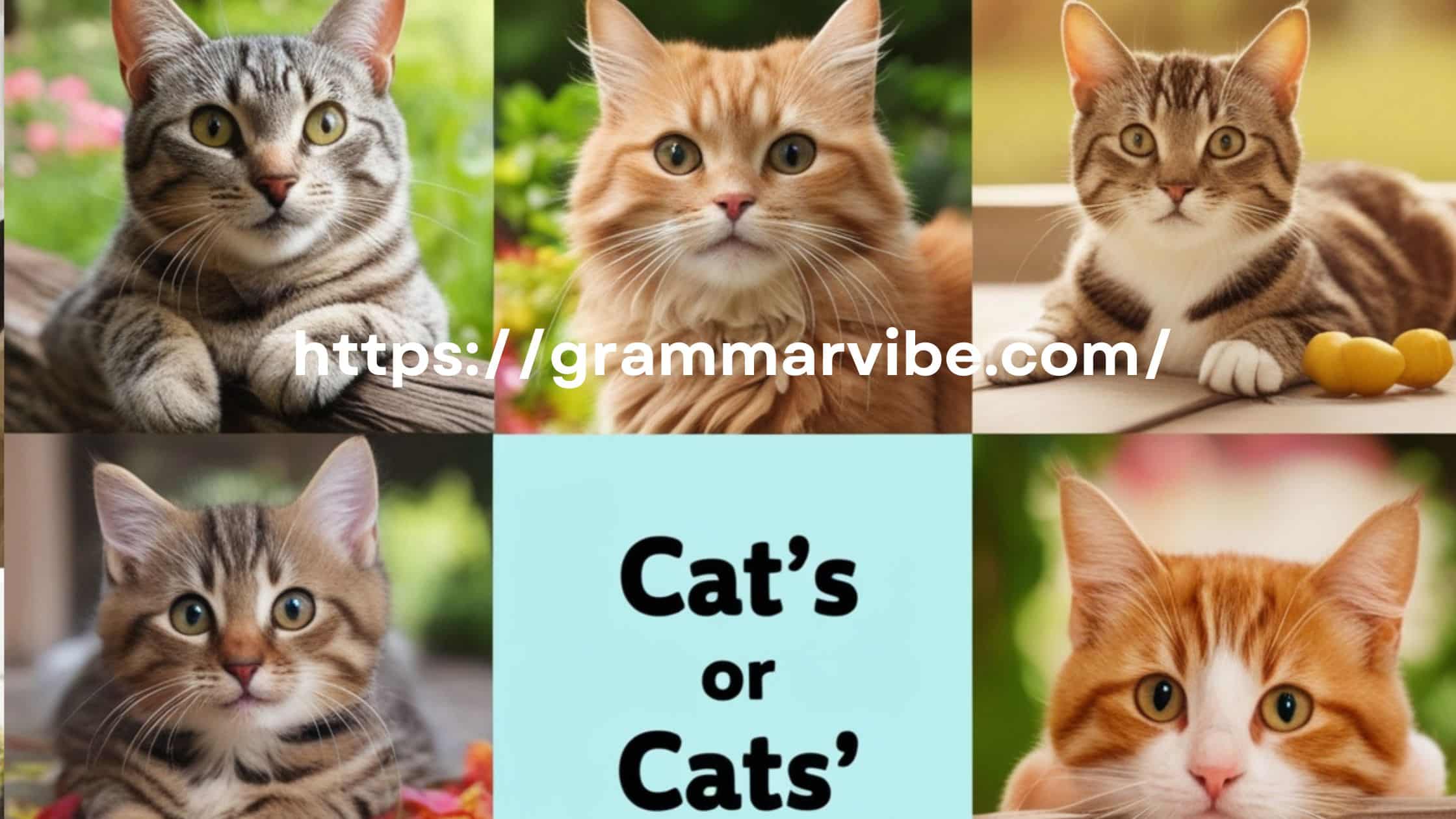When it comes to the English language, one of the common points of confusion revolves around possessive forms, particularly with words like cat and cats. Understanding whether to use “cat’s” or “cats’” can significantly impact your writing, especially when you’re trying to express ownership or belonging.
In this comprehensive guide, we’ll explore the nuances of these terms, including their grammatical roles, usage examples, and the rules for forming possessives. By the end, you’ll be equipped with the knowledge to use these forms correctly, ensuring clarity in your writing.
What Are Possessive Forms?
Definition of Possessive Form
A possessive form is a grammatical construction that indicates ownership or belonging. In English, we typically form possessives by adding an apostrophe and, in some cases, an s to the noun. For example, the possessive form of “cat” is “cat’s,” while the possessive form of “cats” is “cats’.”
Using possessive forms correctly allows you to clarify relationships and ownership in your writing, enhancing the overall comprehension for your readers.
Importance of Understanding Possessives
Understanding possessives is crucial for clear communication. When you use possessive forms correctly, you enhance the reader’s understanding of your writing. This is particularly important in formal writing, where precision is essential. Moreover, it can help prevent misunderstandings in casual conversations and written exchanges.
For instance, if you mistakenly use “cat’s” when you mean “cats’,” your audience might think you are referring to a single cat’s possession rather than the collective possessions of multiple cats.
For your interest: Synonyms for “Communication Skills” on Your Resume
Singular vs. Plural: Understanding the Basics
Singular: Refers to One Item or Entity
In English, the singular form denotes one item or entity. For example:
- Singular Example: “The cat chased a mouse across the yard.”
In this sentence, “cat” is singular, indicating that we’re referring to just one cat. Here, the action of chasing belongs to one specific entity, enhancing the clarity of the statement.
More for you: Williams’s or Williamses’
Plural: Refers to More Than One Item or Entity
The plural form refers to more than one item or entity. To form the plural of most nouns, you simply add an s. For example:
- Plural Example: “The cats lounged in the sun all afternoon.”
In this sentence, “cats” indicates multiple cats. By using the plural form, the reader understands that the action of lounging applies to more than one cat.
Singular and Plural Possessive Forms

Singular Possessive: Cat’s
The singular possessive form indicates something that belongs to one cat. You typically add an apostrophe followed by s.
- Singular Possessive Example: “The cat’s toy was under the couch.”
In this case, the toy belongs to one cat. This construction clearly communicates the relationship between the cat and the toy.
Plural Possessive: Cats’
The plural possessive form is used when referring to something that belongs to multiple cats. For plural possessives, you add an apostrophe after the s.
- Plural Possessive Example: “The cats’ owners were all members of the same family.”
This sentence indicates that the owners belong to multiple cats. The plural possessive here clarifies that the ownership is not limited to a single cat but extends to a group of them.
Check out this: 25 Other Ways to Say “Happy Birthday in Advance”
A Closer Look at Possessive Forms
Understanding when to use cat’s or cats’ requires an examination of context. Let’s break down the components of each possessive form.
Cat: The Singular Form of the Noun
The term cat is the singular form of the noun, representing one individual animal. It follows the standard rule for making countable nouns plural by simply adding an s.
- Singular: “I have one cat.”
- Plural: “She has three cats.”
In this context, “cat” refers to a single entity, while “cats” refers to multiple entities.
Cats: The Plural Form of the Noun
The term cats is the plural form, referring to more than one cat. Understanding this distinction is vital when forming possessives, as the grammatical structure changes based on whether you’re talking about one cat or many.
Cat’s: The Singular Possessive Form
The singular possessive form, cat’s, is used to indicate ownership or something that belongs to one cat.
- Example: “The cat’s whiskers twitched as it sensed the movement.”
In this example, the whiskers belong to one cat. This shows not just possession but also gives insight into the behavior of the cat.
Cats’: The Plural Possessive Form
The plural possessive form, cats’, indicates ownership or something that belongs to multiple cats.
- Example: “The cats’ favorite place to nap was the sunny windowsill.”
In this scenario, the sunny windowsill is a shared favorite place for multiple cats, showing a collective belonging.
For your interest: Brooks’ or Brooks’s
Key Phrases in Context

Let’s look at how these terms are used in various contexts to clarify their meanings.
Using “Cat’s” in Different Scenarios
- In Conversation: “Did you see the cat’s collar? It’s so cute!”
This example showcases a casual conversation where one cat’s collar is being referenced, emphasizing personal ownership. - In Writing: “The cat’s health is very important to me.”
Here, the sentence focuses on one cat’s health, stressing the importance of care. - In a Story: “The cat’s playful nature brought joy to everyone in the house.”
This highlights the characteristics of one cat, demonstrating how its personality affects the surrounding environment.
Using “Cats’” in Different Scenarios
- In Conversation: “I love how the cats’ personalities are so different.”
This statement expresses appreciation for the diverse traits of multiple cats, focusing on the group. - In Writing: “The cats’ toys were scattered all over the living room.”
This example illustrates the collective mess created by multiple cats, indicating shared ownership of their toys. - In a Story: “The cats’ owners planned a trip to the vet.”
This highlights the relationship between the cats and their owners, emphasizing their collective responsibility.
Table of Possessive Forms
| Singular | Plural | Singular Possessive | Plural Possessive |
|---|---|---|---|
| Cat | Cats | Cat’s | Cats’ |
This table summarizes the various forms and highlights how they differ in terms of singularity, plurality, and possession.
More for you: Travis’ or Travis’s
Common Mistakes to Avoid
Even seasoned writers can make mistakes when it comes to possessive forms. Here are some common errors to watch out for:
- Confusing Singular and Plural Possessives: Ensure that you know whether you’re referring to one cat or multiple cats when choosing between “cat’s” and “cats’.” Misusing these terms can lead to confusion about what belongs to whom.
- Omitting the Apostrophe: Always remember to include the apostrophe when indicating possession. “Cats” alone does not indicate ownership; it’s just the plural form.
- Using “Cat’s” for Multiple Cats: Avoid using “cat’s” when you’re referring to the possessions of more than one cat. Stick with “cats’” for clarity, especially in formal writing or communication.
Check out this: Synonyms for “Quick Learner” on Your Resume
Tips for Correct Usage
- Context is Key: Pay attention to the surrounding words in a sentence to determine whether you should use “cat’s” or “cats’.” Context clues often reveal whether you’re discussing one entity or multiple.
- Visualize the Sentence: Sometimes, imagining the scenario can help clarify the possessive form. Picture a single cat versus a group of cats to see which form fits best. This mental image can guide your decision-making.
- Practice with Examples: Creating your own sentences can be a great way to internalize the rules. Try writing a few sentences using both possessive forms. This practice can build your confidence in using them correctly.
- Read Aloud: Hearing your sentences can help you catch mistakes and ensure that they flow naturally. If a sentence sounds awkward or unclear when spoken, it may need revision.
Conclusion: Mastering Cat’s and Cats’
Understanding when to use cat’s and cats’ is crucial for effective communication. By grasping the difference between these possessive forms, you can enhance the clarity and precision of your writing.
Whether you’re writing a casual email, crafting a formal report, or simply sharing a story about your pet, using the correct possessive form helps convey your message clearly. With practice and awareness, you can avoid common pitfalls and express ownership confidently in your writing.
By familiarizing yourself with these forms and using them in various contexts, you’ll strengthen your writing skills and make your work more engaging and clear. Remember to observe the context, choose the right form, and practice regularly to master these possessive forms.

Kyren Paul is an experienced blogger and the creative mind behind “Grammar Vibe.” With a passion for the nuances of English grammar, he brings clarity and insight to everyday language topics, making grammar accessible and engaging for readers of all levels.











Leave a Comment